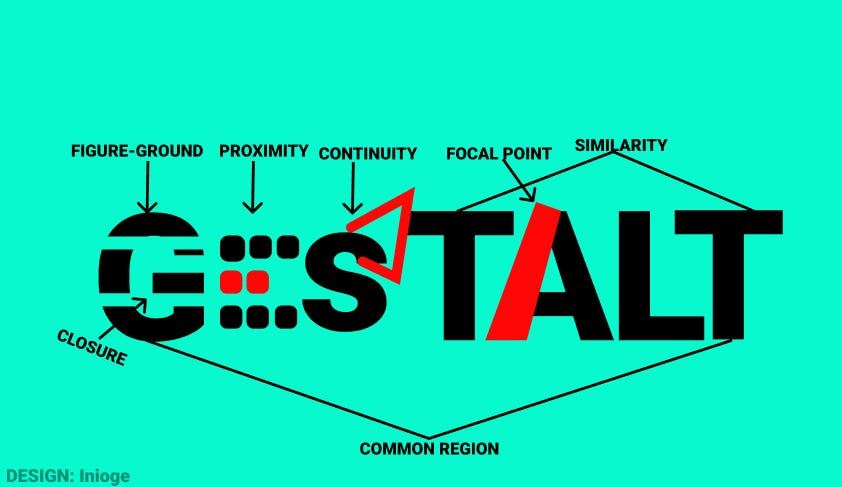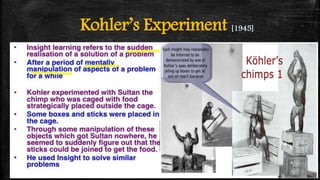Cognitive Field or Gestalt theory was formulated by a group of German Psychologists. The theory emphasizes insightful learning rather than mechanical conditioning. It is believed that meaningful learning can only take place through a sequence of problem-solving approach. In this article, you will learn how learning takes place through the application of logical principles and previous experience.
COGNITIVE FIELD THEORY OF LEARNING
The views of many theorists were collected by Gestalt to formulate a cognitive field theory. Notable among them were Max Wertheimer, Kurt Koffka, and Wolfgang Kohler. Gestalt in German language means “organization or fusion”. This theory rejected the views that consider the learning process in an isolated form rather than in a total or holistic form. The theory does not support associating bits of experiences as postulated in the stimulus-response theories. This theory is of the opinion that parts are configured or organized to make complete or meaningful experiences or impressions. The emphasis here is on the importance of experience, meaning, problem solving and the development of insights. The Gestalt therefore placed more credence on insightful learning rather than trial and error like that of Thorndike or mechanical conditioning as performed by Ivan Pavlov in his classical conditioning theory.
Insightful learning is hinged on the fact that animals undergo a series of problem-solving approach following a sequence of principles or logic and previous experience before arriving at a solution. In this theory, the cognitive or mental processesof the animals are regarded as the yardstick in the development of insightful learning.
 |
| Cognitive Field or Gestalt Theory of learning |
To establish this fact, Gestalt Psychologists performed several experiments using apes as subjects. In one of the experiments, an ape (Sultan) was put in a cage. This sultan was very intelligent. In the cage was a stool and banana, hung on the top of the box. Initially, several unsuccessful attempts were made by the apes to get the banana. Suddenly, sultan decided to pull out the stool and climbed it to pluck the banana from where it was hung. This type of learning is called insightful, because it involves problem-solving approach.
Another experiment was performed with several apes including sultan, put in the box with a banana and a stick lying outside the cage. Several experimental apes stretched their hands to pick the banana from outside but were unsuccessful. The brilliant one among them (sultan) devised a solution by picking the stick outside first and using it to draw the banana closer until its hand touched the banana.
 |
| Kohler's experiment to insightful learning |
The last experiment performed by Kohler on this insightful learning, was an extension of the second experiment. In this case, the apes were put in the cage; banana and two sticks (long and short) were lying outside. None of these two sticks could get to the banana unless by joining them together. The apes in the box made series of attempts to rake in the banana with the two sticks separately without succeeding. It was sultan who later manipulated and fixed the two sticks together before it could finally collect the banana. All these experiments indicated that learning cannot take place in a segregated way but in a complete form.
Insightful learning therefore adopts the following strategies in learning:
(a) identify and define the problem or task;
(b) formulate the hypotheses;
(c) come out with different solutions;
(d) select /implement the viable solution; and
(e) evaluate / appraise the selected solution or revisit the problem.
Differences between Behaviourists and Gestalt Theories of Learning
| BEHAVIOURISTS THEORIES | GESTALT THEORIES |
| 1. Response is programmed i.e. mechanical | Response is systematic and organised in cognitive structure. |
| 2. This learning takes place through trial and error or trial and success | The learning process is based on the problem-solving approach |
| 3. Learning is temporal. Extinction can set in if the learning is not reinforced | Learning is permanent experience gained and can be used or transferred into another related task. |
| 4. The result or outcome is the ultimate of the behaviourists | Gestalt are more interested in the processes and justification of a task. |
| 5. In this type of learning, learner becomes onlooker (passive) while he is being manipulated or subjected to a particular condition. | The learner plays an active part in gestalt learning. The learner is involved in finding out the solutions to the problems being investigated. |
| 6. This type of learning is simple. It is good for elementary learning | Gestalt learning is a complex one. It is good for higher thinking. It is good where the learner will have to reason logically and analytically before having a meaning solution to the problem. |
| 7. Behaviourists believe more on teacher-centeredness. Most of the processes to the solution are done by the teacher. | Cognitive theorists emphasize learner-centred approach. They believe in the “doing it yourself” system. |
| 8. There is no association or interrelatedness of the problems. | This theory organises the problems so that the learners can know the relationship between or among them. e.g. in one of the experiments, Gestalt placed banana and sticks side by side to show their relationship. |
CLASSROOM IMPLICATIONS OF GESTALT THEORY
1. This theory has developed the concept that learners have different needs and concerns at different times, and that they have subjective interpretations in different contexts.
2. The teacher should realize the importance of instructional aids during teaching-learning activities, hence he/she should make use of teaching aids for a meaningful learning in the classroom.
3. The teacher should make his/her teaching more participatory to the students. It is on this basis that the teacher will be able to discover the hidden talents in his/her students.
4. If the classroom experiences of the students are related, students will be able to transfer the gained experience into future learning. This will then promote interrelatedness.
5. The teacher should not neglect the use of motivational strategies in teaching -learning activities. This reinforcement will stimulate the efforts of the students in the classroom.









0 Comments